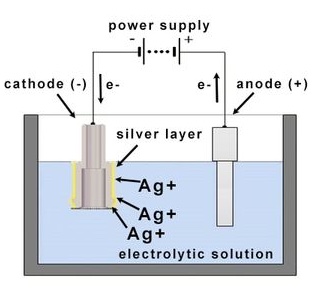
Technology
Silver coating
Reduced risk of infection.
Silver coating
Background
In 2004 implantcast, in close collaboration with Münster University Hospital, developed a unique silver coating which has been successfully applied to a wide variety of MUTARS® tumor system components.
Our silver coated devices are used to reduce the risk of infection and thus increase implant survivorship.

Infections
Infection is the most serious complication in the field of endoprosthetic tumour surgery. According to the literature infection rates range from 5 to 35% despite adequate local and systemic antibiotic prophylaxis.1 Reasons for this include long surgery times and extensive exposure as well as immunosuppression and the increasing resistance of bacteria to antibiotics.
The lifetime of an endoprosthesis in vivo is usually limited by septic and aseptic loosening. Both scenarios are triggered by the patient mounting an inflammatory response directed against either the bacteria adhering to the implant surface or against the presence of unknown "low grade" infections and/or wear particles respectively.
Silver
Silver, and in particular free silver ions, are known for their broad antimicrobial spectrum. Components with silver coatings demonstrated a reduction in the bacterial colonisation of prosthetic surfaces. The risk of an inflammatory response and hence the associated loosening mechanism is reduced. In turn the patient is spared an infection-induced revision surgery or, at worst, amputation. The advantages of a silver coating over antibiotic coatings include the continuous and long-lasting antimicrobial effect of the silver ions as well as the more resistance to biofilm formation.1
The effectiveness of the silver coating has been demonstrated in clinical use.2-6
At present, all implant surfaces can be coated with silver, which are not in direct bone contact or which are not involved in the articulation of the prostheses.
So far, silver-coated components have been successfully used in 12,500 treatments.
The film shows the case of a female patient with a silver-coated MUTARS® Proximal Femur
The advantages of a silver coating:
- reduced infection rates
- long-term prophylaxis through continuous silver ion release
- resistance to biofilm formation
- record of successful in clinical use
Technology
The 15μm (±5μm) thick silver coating is applied by electroplating to the surfaces of our cobalt chromium molybdenum alloy (CoCrMo) and titanium alloy (TiAl6V4) components.
Since these materials cannot be directly coated with silver a thin layer of gold (approximately 0.2μm) is first applied to the implant surfaces to be coated to act as a carrier and bonding layer to the implant.
During the electroplating process a silver electrode serves as an anode and the implant component to be coated serves as a cathode. After application of a voltage, electrons (e-) and silver ions (Ag+) migrate from the silver electrolyte solution to the implant component to form the desired silver layer. The components are subsequently treated and cleaned.

1 Gosheger et al. 2004. Silver-coated megaendoprostheses in a rabbit model – an analysis of the infection rate and toxicological side effects. Biomaterials 25, 5547-5556.
2 Hardes J, von Eiff C, Streitbuerger A, Balke M, Budny T, Henrichs MP, Hauschild G, Ahrens H. Reduction of periprosthetic infection with silver-coated megaprostheses in patients with bone sarcoma. J Surg Oncol. 2010 Apr 1; 101(5):389-95.
3 Hardes J, Henrichs MP, Gosheger G, Hauschild G, Guder W, Dimostheneous A, Nottrott M, Streitbuerger A. Silver-coated megaprostheses of the proximal tibia in patients with bone sarcoma. Abstractbook of EMSOS 2016. ID-1073. 29th Annual Meeting of the European Musculo-Skeletal Oncology Society (EMSOS); May 25 – May 27, 2016; La Baule, France.
4 Hussmann B, Johann I, Kauther MD, Landgraeber S, Jäger M, Lendemans S. Measurement of the silver ion concentration in wound fluids after implantation of silver-coated megaprostheses: correlation with the clinical outcome. Biomed Res Int. 2013; 2013:763096.
5 Donati, F., Di Giacomo, G., D’Adamio, S., Ziranu, A., Careri, S., Rosa, M. A., & Maccauro, G. (2016). Silver-Coated Hip Megaprosthesis in Oncological Limb Salvage Surgery. BioMed Research International, (2016).
6 Henrichs MP, Krebs J, Gosheger G, Streitbuerger A, Nottrott M, Sauer T, Hoell S, Singh G, Hardes J. Modular tumor endoprostheses in surgical palliation of long-bone metastases: a reduction in tumor burden and a durable reconstruction. World J Surg Oncol. 2014 Nov 7; 12:330.